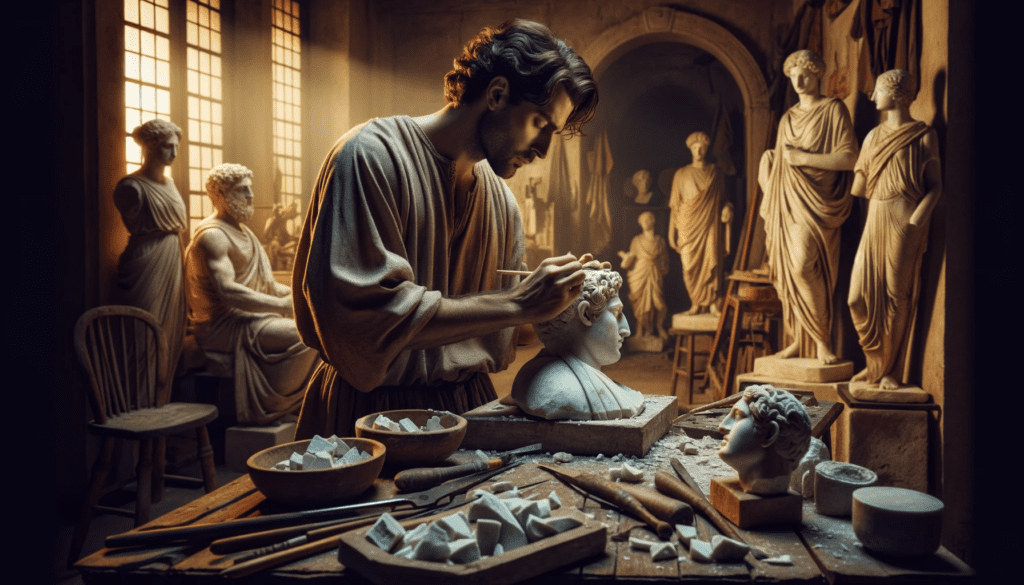Marble, a rock that has symbolized luxury and sophistication for centuries, has made a fascinating journey from the earth to our homes and offices. In this article we dive into the world of marble: how it is created, what it is used for, how it is worked, and the wonderful creations that result.
How Does Marble Form?
Marble begins its life deep beneath the earth’s crust as limestone. The combination of intense heat and pressure slowly transforms limestone into marble, a process called metamorphosis. This metamorphosis creates the characteristic veiny patterns and rich variety of colors that make marble so desirable. Each piece of marble is unique, adding to its exclusivity.
Variety of Colors in Marble
Although many people think of marble as white or light gray, the rock can have a wide range of colors depending on the minerals present during its formation. For example, iron can give marble a pink or reddish hue, while the presence of carbon can result in black marble.
Applications of Marble
Marble has been used in construction and art for millennia. In ancient Greece and Rome, it was widely used for sculptures and in the construction of temples and palaces. Today, marble is still popular in architecture and interior design.
Marble in Interior Design
In modern homes, you often find marble in kitchen countertops, bathrooms, floors and as a decorative element. The coolness of marble also makes it ideal for warmer climates, where it can help keep interiors fresh.
Marble Machining
The process of transforming raw marble into a refined product is an art in itself. Marble is quarried and then cut into slabs or blocks. These are then further processed to the desired shape and finish.
Techniques for Marble Processing
The processing of marble requires specific techniques to highlight its natural beauty. Polishing is a common method used to bring out the color and veins and give the surface a glossy finish. Other techniques such as sawing, sanding and engraving are also used to create different textures and designs.
The Challenges of Marble Working
Working marble requires skill and precision, especially since it is a relatively soft and porous rock. Improper handling can lead to cracks or fractures. Therefore, specialized tools and techniques are used to ensure the quality and durability of the final product.
Marble in Art and Architecture
Throughout history, marble has held a prominent place in art and architecture. From the Greek statues to the opulent palaces of Europe, marble symbolizes elegance and timeless beauty.
Marble Masterpieces
Some of the most famous works of art, such as Michelangelo’s David and the Venus de Milo, are carved from marble. These works show the versatility and beauty of marble and to this day are a source of inspiration for artists around the world.
Marble in Contemporary Architecture
Even in contemporary architecture, marble remains a favorite choice for both interior and exterior designs. Marble’s natural appearance and durability make it an ideal material for a wide range of applications, from floor tiles to cladding.
The Disadvantages of Marble
Although marble has many advantages, there are also some disadvantages to consider when choosing this material:
Sensitivity to Stains and Scratches
Marble is porous, which means it can absorb liquids and develop stains, especially from acidic substances such as lemon juice and vinegar. It is also more susceptible to scratching than some other types of stone, which requires extra caution in daily use.
Maintenance and Sustainability
Regular maintenance is essential to keep marble beautiful. This may include periodic polishing and sealing to protect the surface. Marble can also lose its luster over time and can be affected by erosion, especially in outdoor applications.
Cost
Marble is often more expensive than other natural stones or artificial alternatives. Costs can add up, especially for high-value varieties and complex installations.
Conclusion
Marble is more than just a rock; it is a symbol of sophistication and a testament to the natural beauty of our planet. From its origins beneath the earth’s crust to its place in our homes and works of art, marble continues to fascinate and inspire us. It is the combination of aesthetics, versatility and durability that makes marble a timeless favorite in the world of design and architecture. With proper care and maintenance, marble can be a beautiful and durable choice for many applications, although its drawbacks must be carefully considered.








Leave a Reply